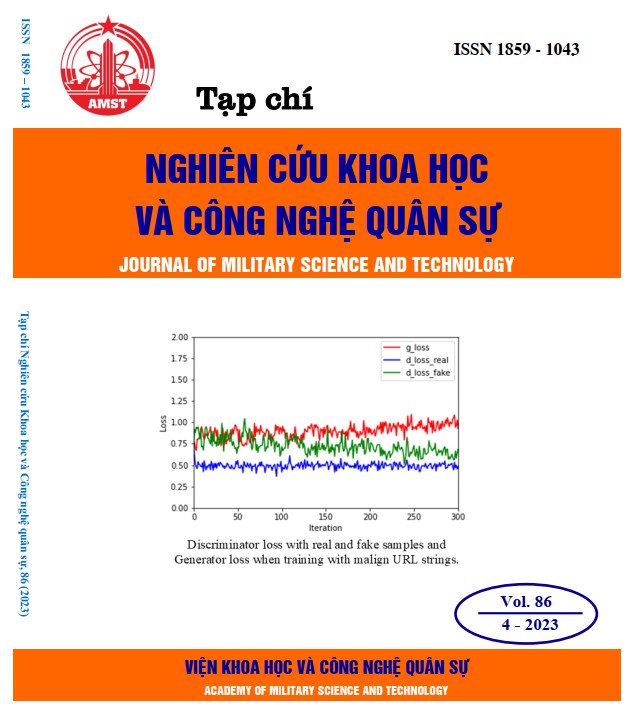Assessment of removal of the odor compounds from livestock (H2S, NH3) of some microbial strains isolated from Truong Sa islands
457 viewsDOI:
https://doi.org/10.54939/1859-1043.j.mst.86.2023.79-85Keywords:
Heterotrophic bacteria; Oxidizing ammonia; Oxidizing sulfide.Abstract
In this study, 4 strains with the activity of sulfide oxidation and 6 strains with the activity of ammonia oxidation were isolated from samples of soil, and livestock wastewater on Truong Sa Islands. The strains that removed the volatile odorous compounds (ammonia, hydrogen sulfide) were cultivated on either thiosulfate agar supplemented yeast, glucose or Vinograxki media added with glucose, and citrate mineral. The results showed that the strains (AOBN4, SOBS9) have the ability to reduce pH in the culture medium to pH 4 - pH 5, are resistant to NaCl concentration of 30 g/l, are heat resistant at 40oC, which are suitable for the conditions on the Truong Sa islands. On the other hand, AOBN4 has an ammonia removal efficiency of 73% and SOBS9 has the ability to convert thiosulfate to sulfate ion up to 5,9 mg/ml. These results indicate that the isolated strains have effective deodorization (NH3, H2S) and the potential to be applied to the production of microbial preparations for livestock waste treatment in islands.
References
[1]. Rameshkumar P., “Microbiological and molecular characterization of sulfur oxidizing Pseudomonas sp. PRK786 isolated from cattle manure compost”, International journal of Advanced Research, Vol. 2, No.3, pp. 714 – 722, (2018).
[2]. Hidayat M.Y., “Isolation and characterization of Sulphur oxidizing bacteria isolated from hot spring in Malaysia for biological deodorization of hydrogen sulfide in chicken manure”, Media Peternakan, Vol. 40, No 3, pp. 178 – 187, (2017). DOI: https://doi.org/10.5398/medpet.2017.40.3.178
[3]. Hou N., “H2S biotreatment with sulfide oxidizing heterotrophic bacteria”, Biodegradation, Vol. 29, No 6, pp. 511-524, (2018). DOI: https://doi.org/10.1007/s10532-018-9849-6
[4]. Behera B.C., “Sulphur oxidizing bacteria in mangrove ecosystem: a review”, African Journal of Biotechnology, Vol. 13, pp. 2897 – 2907, (2015). DOI: https://doi.org/10.5897/AJB2013.13327
[5]. Chen X.G., “Isolation and characterization of sulfur oxidizing Thiomonas sp. and its potential application in biological deodorization”, Letters in Applied Microbiology, Vol. 39, pp. 495 -503, (2004). DOI: https://doi.org/10.1111/j.1472-765X.2004.01615.x
[6]. Takenaka S., “Isolation and characterization of thermotolerant bacterium utilizing ammonium and nitrate ions under aerobic conditions”, Biotechnol Lett, 29, pp. 385 – 390, (2007). DOI: https://doi.org/10.1007/s10529-006-9255-8
[7]. Hee-Wook Ryu, “Thermophilic biofiltration of H2S and isolation of a thermophilic and heterotrophic H2S-degrading bacterium, Bacillus sp. TSO3”, Journal of Hazardous Materials, Vol. 168, pp. 501–506, (2009). DOI: https://doi.org/10.1016/j.jhazmat.2009.02.046
[8]. Li H., “Isolation and evaluation of endophytic Bacillus tequilensis GYLH001 with potential application for biological control of Magnaporthe oryzae”. PLOS one, (2018), DOI: https://doi.org/10.1371/journal.pone.0203505. DOI: https://doi.org/10.1371/journal.pone.0203505
[9]. Yang Y., “Heterotrophic nitrogen removal in Bacillus sp. K5: involvement of a novel hydroxylamine oxidase”, Water science and technology, pp. 1-8, (2017). DOI: https://doi.org/10.2166/wst.2017.510
[10]. Yang, X. P., “Isolation and nitrogen removal characteristics of an aerobic heterotrophic nitrifying-denitrifying bacterium, Bacillus subtilis A1”, Bioresource Technology, Vol. 102, No. 2, pp. 854–862, (2011). DOI: https://doi.org/10.1016/j.biortech.2010.09.007
[11]. Yao, Y. C., “Simultaneous removal of organic matter and nitrogen by a heterotrophic nitrifying-aerobic denitrifying bacterial strain in a membrane bioreactor”, Bioresource Technology, Vol. 43, pp. 83–87, (2013). DOI: https://doi.org/10.1016/j.biortech.2013.05.120
[12]. Sato, “Analysis of malodorous volatile substances of human waste: feces and urine”, Journal of health science, Vol. 47, No. 5, pp. 483-490, (2001). DOI: https://doi.org/10.1248/jhs.47.483
[13]. Yao, R. L., “Isolation and characteristics of heterotrophic nitrification-aerobic denitrification bacterium, Bacillus cereus X7 at high salinity”, Environmental Engineering, Pts 1- 4, pp. 111-114, (2014). DOI: https://doi.org/10.4028/www.scientific.net/AMR.864-867.111
[14]. Dai J, “Production of highly active extracellular amylase and cellulase from Bacillus subtilis ZIM3 and a recombinant strain with a potential application in tobacco fermentation”, Frontiers in Microbiology, Vol. 11, No. 1539, pp. 1-14, (2020). DOI: https://doi.org/10.3389/fmicb.2020.01539
[15]. Kim, “Enhancement of microbial nitrification to reduce ammonia emission from poultry manure: a review”, World's Poultry Science Journal , Vol. 70, No. 4, pp. 839 – 856, (2014). DOI: https://doi.org/10.1017/S0043933914000890
[16]. Ardiansyah, “The selected facultative mixotrophic sulfur oxidizing bacteria from intensive shrimp ponds”, AACL Bioflux, Vol. 13, No. 5, pp. 2886 -2896, (2020).
[17]. Zhang Duoying, “Isolation, Identification and Characterization of heterotrophic nitrifying bacteria from surface water”, Advanced aterials Research, Vol. 726, pp. 406 – 411, (2013). DOI: https://doi.org/10.4028/www.scientific.net/AMR.726-731.406







